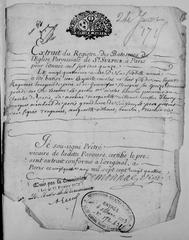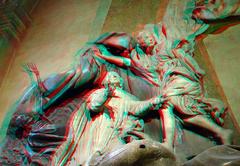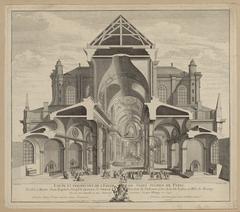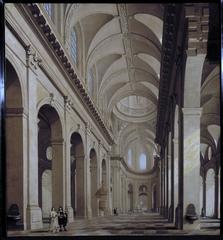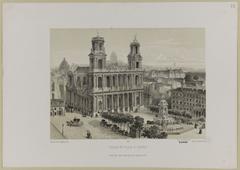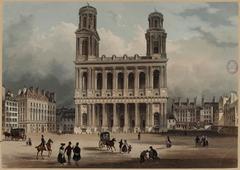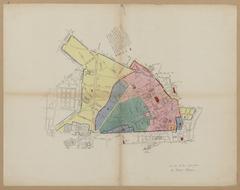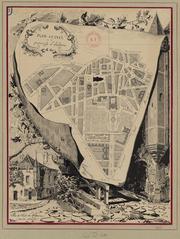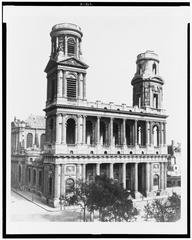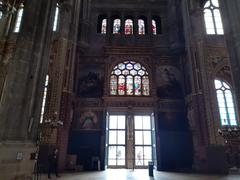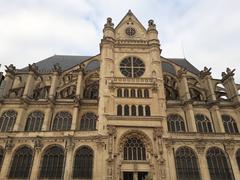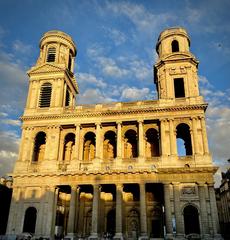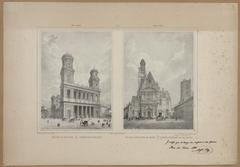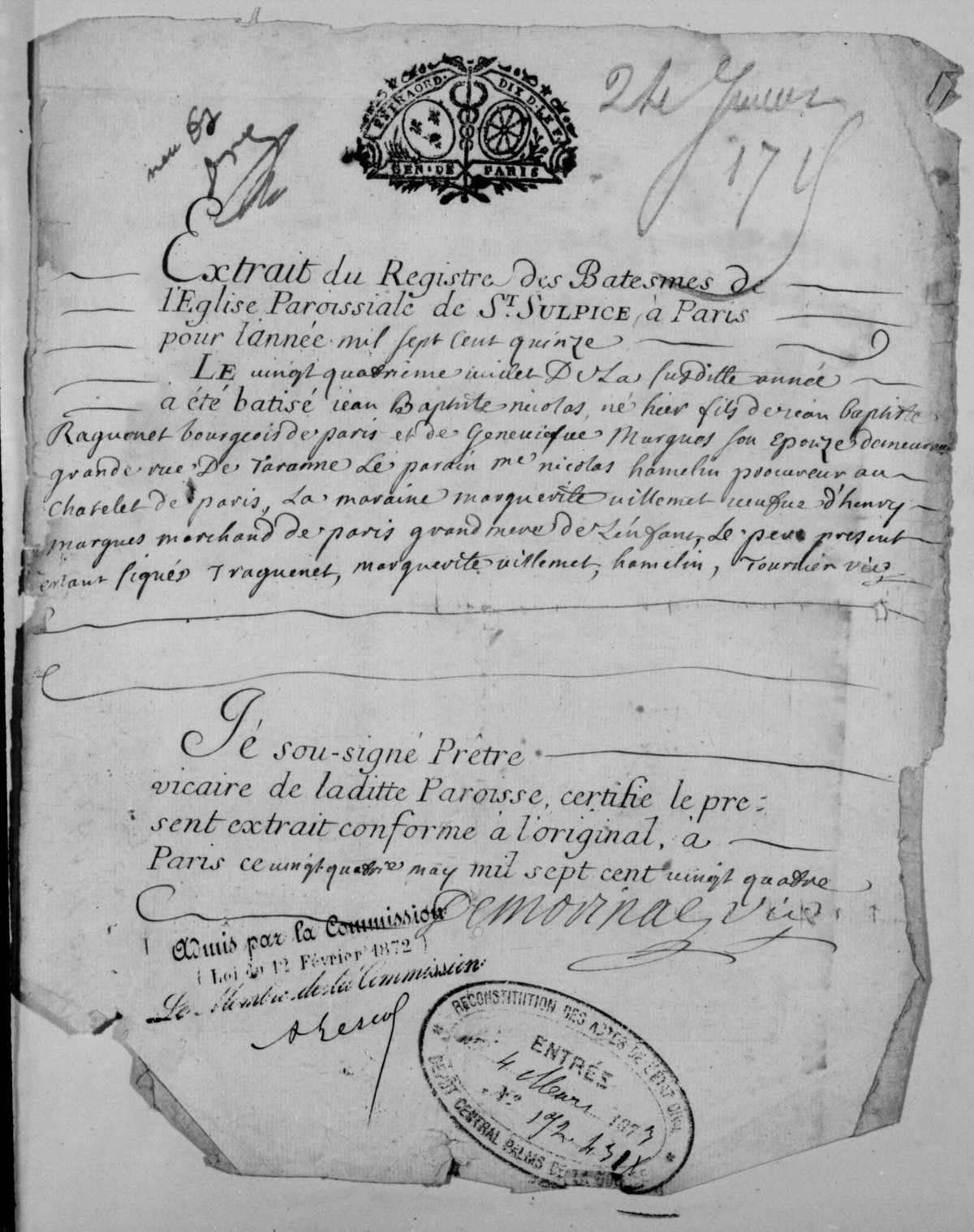
Church of Saint-Sulpice Paris: Visiting Hours, Tickets, and Historical Significance
Date: 14/06/2025
Introduction: History and Cultural Importance
Located in Paris’s vibrant 6th arrondissement, the Church of Saint-Sulpice stands as a monumental symbol of French religious, architectural, and cultural heritage. As the second largest church in Paris, Saint-Sulpice captures the city’s dynamic history, evolving from its modest medieval origins through centuries of architectural transformation. The church’s unique blend of Romanesque, Baroque, and Neoclassical styles, along with its artistic treasures and scientific marvels, make it a must-visit for history, art, and architecture enthusiasts (Saint-Sulpice France; History Hit; Delve Into Europe).
Saint-Sulpice is renowned for its asymmetrical façade, the evocative Delacroix murals in the Chapel of the Holy Angels, and the celebrated Cavaillé-Coll grand organ. Its 18th-century astronomical gnomon, a rare scientific instrument, reflects the Enlightenment-era intersection of faith and science (The Catholic Travel Guide; Paris Perfect; TravelAwaits). The church remains both a vibrant parish and a prominent cultural landmark, featured in literature such as Dan Brown’s “The Da Vinci Code” and in key moments of French history (Klook; Travelfranceonline).
This guide provides essential information on Saint-Sulpice’s history, architecture, visiting hours, tickets, travel tips, and nearby attractions, ensuring a rewarding visit to one of Paris’s most iconic historical sites.
Historical Overview
Medieval Foundations
The earliest church on the site dates to the 12th or 13th century, serving the growing Left Bank community under the influence of Saint-Germain-des-Prés (Saint-Sulpice France). Over time, expansions added a longer nave, a new apse with seven chapels, and additional side aisles. By the 17th century, the original Romanesque church was replaced by the current grand design to accommodate a burgeoning parish (Travelfranceonline).
The Grand Reconstruction (17th–18th Centuries)
Vision and Construction
Jean-Jacques Olier, appointed parish priest in 1642, initiated the construction of a new church that would rival Rome’s Saint Peter’s Basilica (History Tools). The foundation stone was laid in 1646, with a series of prominent architects—Gamard, Le Vau, Gittard, and later Servandoni—shaping the final structure. Financial and political challenges delayed construction, which spanned nearly 140 years. The main structure was completed by 1733, and the church consecrated in 1745, though the twin towers were finished much later and remain asymmetrical (Paris Insiders Guide; The Not So Innocents Abroad).
Architectural Features
Saint-Sulpice is notable for its 120-meter length and 57-meter width, with a Latin cross floor plan, wide nave, and side chapels. The façade—designed by Giovanni Servandoni—features two tiers of Doric and Ionic columns, and its asymmetrical towers are a result of the interrupted and lengthy construction process (Travelfranceonline; Paris Insiders Guide).
Artistic, Scientific, and Religious Significance
The Great Organ
Saint-Sulpice houses one of the world’s largest and most acclaimed pipe organs. Originally built by François-Henri Clicquot in 1776, it was later expanded by Aristide Cavaillé-Coll in 1862 to its current 7,000-pipe grandeur (Travelfranceonline; The Catholic Travel Guide). The organ remains a focal point for music lovers, with regular recitals held in the church.
The Gnomon
Installed in the 18th century, the gnomon is an astronomical device used to determine the equinoxes and regulate the liturgical calendar. Its brass line, marble obelisk, and sunlight aperture exemplify the church’s Enlightenment-era embrace of science (TravelAwaits).
Delacroix Murals
The Chapel of the Holy Angels features three murals by Eugène Delacroix: “Jacob Wrestling with the Angel,” “Heliodorus Driven from the Temple,” and “Saint Michael Vanquishing the Demon.” These masterpieces are among the finest religious artworks in Paris (The Catholic Travel Guide; TravelAwaits).
Religious and Cultural Legacy
The adjoining seminary, founded by Olier, established the Society of Saint-Sulpice and became a major center for Catholic education (History Tools). The church has played roles in pivotal events, from the French Revolution (when it became the “Temple of Victory”) to the marriage of Victor Hugo and the funeral of Jacques Chirac (Paroisse Saint-Sulpice; TravelAwaits). Literary fame has followed, especially since its appearance in “The Da Vinci Code” (The Not So Innocents Abroad).
Visitor Information
Visiting Hours
- General Hours: Daily from 7:30 AM to 7:30 PM (may vary on holidays or during special events; check the official website before visiting).
- Organ Concerts: Sundays, 11:30 AM–12:05 PM, open to the public.
Tickets and Entry
- Admission: Free of charge (donations welcome).
Accessibility
- Ramps at main entrances and staff assistance available.
- Some historic areas may have uneven flooring.
Getting There
- Metro: Saint-Sulpice (Line 4).
- Bus: Several lines serve the area.
- On Foot: Close to Luxembourg Gardens and Boulevard Saint-Germain.
Guided Tours
- Guided tours (French and sometimes English) are available through the parish and local operators.
- Audio guides can be rented on-site or downloaded.
Amenities
- No restrooms inside; facilities available nearby.
- Cafés and restaurants in the surrounding square.
Architectural and Artistic Highlights
Exterior
- Façade: Asymmetrical twin towers, Doric and Ionic columns, Neoclassical-Baroque blend (Paris Perfect; Delve Into Europe).
- Fountain: The Fontaine Saint-Sulpice (1848), with statues of French bishops.
Interior
- Nave: Vast, light-filled, with soaring vaults and massive pillars.
- Chapelle des Anges: Delacroix murals.
- Organ Loft: Home to the grand Cavaillé-Coll organ.
- Gnomon: Scientific meridian line and obelisk.
- Pulpit: Marble and gilded figures symbolizing Faith, Hope, and Charity.
- Unique Features: Holy water fonts made from giant clamshells, vibrant stained glass, and a reproduction of the Shroud of Turin.
Visitor Etiquette
- Dress modestly; avoid shorts and casual sportswear.
- Maintain silence, especially during services.
- Photography allowed (no flash); restrictions may apply during Mass or special events.
Nearby Attractions
- Luxembourg Gardens
- Saint-Germain-des-Prés neighborhood
- Odéon Theater
- Notre-Dame Cathedral, Louvre Museum, Sainte-Chapelle (short distance by metro or on foot)
Frequently Asked Questions (FAQ)
Q: What are Saint-Sulpice’s opening hours?
A: Typically 7:30 AM to 7:30 PM daily; check for updates on holidays or special events.
Q: Is there an entry fee?
A: Entry is free; donations are appreciated.
Q: Are guided tours available?
A: Yes, through the parish and some local operators.
Q: Is the church accessible for people with disabilities?
A: Yes, the main entrance is accessible.
Q: Can I attend organ concerts?
A: Yes, they are held most Sundays.
Q: Are restrooms available?
A: Not inside; use nearby facilities.
Visuals and Interactive Media
- Official virtual tour and map
- Image suggestions: façade with asymmetrical towers, Delacroix murals, organ loft, and gnomon.
- Alt tags: “Saint-Sulpice visiting hours,” “Saint-Sulpice tickets,” “Paris historical sites.”
Plan Your Visit
Saint-Sulpice offers a unique blend of history, art, and spirituality. Prepare for your visit with practical information, and explore related Paris landmarks to enrich your experience. For up-to-date events, guided tour bookings, and exclusive audio tours, download the Audiala mobile app and follow us on social media.
Summary
The Church of Saint-Sulpice remains a monumental symbol of Parisian history, art, and spirituality. Its architectural evolution, artistic masterpieces, and scientific marvels—alongside free entry and a welcoming atmosphere—make it a highlight of any Paris visit. For updated information, use the official website, the Audiala mobile app, and trusted travel resources (Saint-Sulpice France; TravelAwaits; Paris Perfect; Delve Into Europe; Klook; Saint-Sulpice Paris).
Sources
- Saint-Sulpice France
- History Hit
- Paris Perfect
- Delve Into Europe
- Klook
- Travelfranceonline
- The Catholic Travel Guide
- TravelAwaits
- History Tools
- Paris Insiders Guide
- The Not So Innocents Abroad
- Saint-Sulpice Paris Official Website
